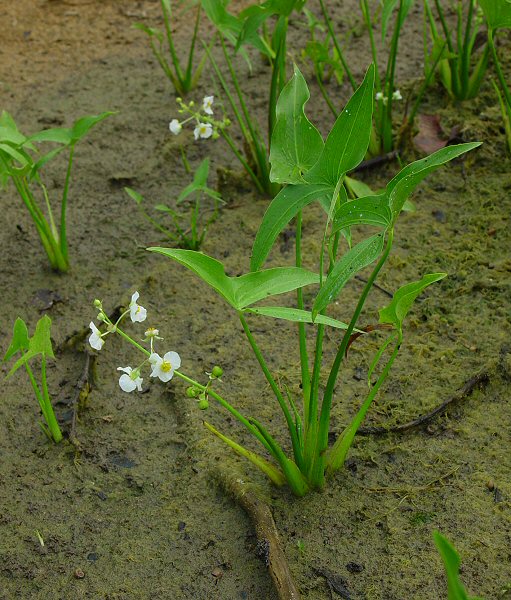Sagittaria latifolia Willd.
Duck Potato

Native
CC = 4
CW = -5
MOC = 52
© DETenaglia
Sagittaria latifolia Willd.Duck Potato | |
 |
Native CC = 4 CW = -5 MOC = 52 |
© DETenaglia |
|
Family - Alismataceae Habit - Perennial forb. Rhizomes, corms, and stolons variously present. Stems - Aerial stems absent. Leaves - All basal, simple, entire, long-petiolate, 10-150 cm long. Petioles somewhat inflated and rounded or less commonly flattened. Blades of rare submerged leaves absent or linear. Blades of emergent leaves sagittate to hastate. Venation with several pairs of main veins arching from the base of the midrib and rejoining near the apex and the tips of the lobes (when present), these connected by finer, angled veins running parallel to one another.
Inflorescence - Racemes with whorled flowers, sometimes branched near the base, ascending or erect. Bracts at inflorescence nodes 0.4-1.3 cm long, free or fused at the base, boat-shaped, rounded to acute at the apex. Lower 1-5 whorls of flowers pistillate, with ascending, unthickened pedicels 10-60 mm long. Upper flower whorls staminate.
Flowers - Mostly unisexual. Sepals ovate, persistent, reflexed in fruit. Stamens many, the filaments longer than the anthers, not swollen basally, glabrous. Pistils many, in a dense spiral cluster on the globose, expanded receptacle. Styles terminal or lateral.
Fruits - Numerous achenes in a dense, headlike cluster on an expanded receptacle. Achenes flattened, obovate, 2.5-4.0 mm long, the beak 0.6-1.6 mm long, narrowly triangular, spreading at a right angle to the body of the fruit.
Flowering - June - October. Habitat - Pond margins, mud flats, ditches, sloughs, marshes, wet open areas. Origin - Native to the U.S. Lookalikes - Other members of the genus, especially S. brevirostra and S. calycina. Other info. - This common denizen of mud flat areas occurs across most of Missouri, though it is less common toward the west and north of the Missouri River. It also occurs across the continental U.S., but is most common in the eastern 2/3 of the country. Photographs taken along the shores of the Current River, Shannon County, MO., 8-17-03 (DETenaglia); also near Treloar, Warren County, MO, 8-2-2011, Shaw Nature Reserve, Franklin County, MO, 08-11-2011, Onondaga Cave State Park, Crawford County, MO, 08-20-2014, and Marais Temps Clair Conservation Area, St. Charles County, MO, 08-14-2017 (SRTurner). |